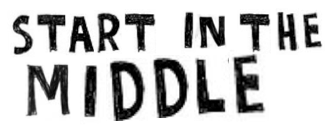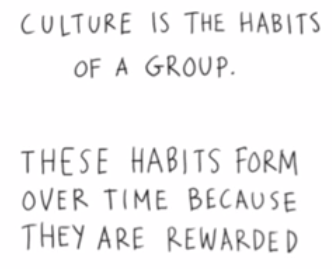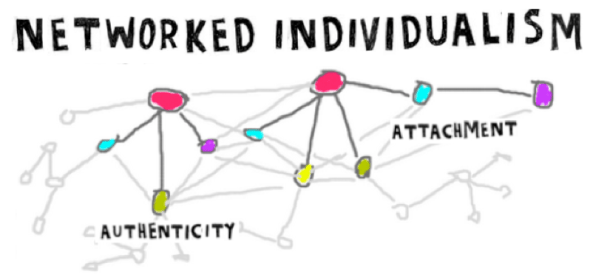dave gray – start in the middle

social company…

don’t wait till it’s finished – put it out there….
find/follow him here:
his visual thinking school:
visual language is a way to communicate in a non-linear way…
____________
talk on culture and change, dec 2013:
if you want to change the culture, you have to start discussing the undiscussable..
____________
his site:
book links to amazon
________________
notes from book:
[met Dave at bif6.. he gave everyone his book]
p. 9 – new option for public ed – no?:
Customers don’t need to revolt in an active way. All that is required is for a new company to come along and offer a better service. Connected customers will become aware of such services far more easily than they have in the past, and share the information more quickly, too. If the new service is interesting, it will quickly cascade through the network.
p. 28 – measure of success:
At every point of interaction the measure of success is not a product but the satisfaction, delight, or disappointment of the customer.
p. 71 – don’t know how to learn:
The problem is that while today’s companies are very good at processing inofrmation and producing outputs, they don’t know ow to learn.
p. 79 & 95- disruptive sustainability (scale the individual):
While a machine does whatever it was designed to do organisms control themselves. An organism’s purpose does not come from an outside designer or controller, but from within.
And happy, loyal customers [people] are the only driver that will yield success in the long term.
p. 112 – what school has become:
The thing is, moments of truth come in so many varieties that it’s impossible to predict every situation and plan for it in advance. Even if you could, the manual of procedures would be so thick that front-stage worker could never look up the procedures in time.
Over time, most processes become rigid, bureaucratic, and bloated with rules, regulations, and procedures for handling this or that.
The purpose of all these procedures and rules is to ensure that the rank-and-file employee doesn’t have to make decisions.
p. 113 – service economy:
no physical product to measure, services are experiences and the only quality that matters is subjective – how a person perceives the experience (flavors of success)
p. 116 – can’t learn in a box, learning requires freedom to experiment, training (industrial) vs learning (today)
p. 125 – iterative development
the farther ahead you plan, more likely you’ll be wrong
Alan Kay – object orientation – system of interacting objects instead of list of instructions – each object – its own independent machine – scale the individual – service orientation
p. 137 – holarchy – starfish – fractal
p. 139 – Nordstrom employee handbook:
Use your best judgment in all situations. There will be no other rules.
p. 170 – entrepreneurs are not geniuses, they just have a bias toward action
p. 171 – tacit & explicit knowledge chart *(see rambling question on tacit below)
Knowledge can be classified into tow categories: explicit knowledge, which can be counted quantified, documented, and easily shared, and tacit knowledge, which includes things that are difficult to measure and share, like expertise, technical know-ow, informal relationships, intuition, metal models, beliefs, and trust. It is tacit knowledge that constitutes our understanding of reality, and tacit knowledge makes up the bulk of the knowledge in most organizations. As the saying goes, the company’s intellectual property walks out the door every evening.
p. 202 – on experimenting:
Jeff Bezos, Amazon: You need to set up and organize so that you can do as many experiments per unit of time as possible.
[imagine 7 billion experiments a day – or even just 4 billion]
p. 205 – Gabe Newell’s Valve – 100% self-directed [disruptive sustainability]:
Nobody is directing people where to go and what to do. Nobody is allocating resources from the top. People are resources self-organize based on horizontal, peer-to-peer activity.
p. 210 – Drucker quote:
Peter Drucker once said, “Management is doing things right. Leadership is doing the right things.” If Drucker is right, and I believe he is, then leadership must come first. For if the leader isn’t setting the right direction in the first place, then it doesn’t matter how well the company is managed [school], because it will be managing the wrong things.
________________
*wondering how much is lost going from tacit to explicit.. and how much explicit is needed today
what if it is more about visuals – on the spot – just in time – rather than storing up explicit knowledge – that often is held at a distance – compromising aliveness – of the knowledge and of the people
what if communication emerges more on a tacit level – so that we are all swimming in it more – having to – getting to – stay alive.
could we get to the place where the only detailed knowledge needed is within communities of practice, who are already at the same tacit level?
we work on fractal knowledge for communicating between communities?..
what if all that’s needed for explicit-ness – is already..?
i don’t know
______________
via http://maryannreilly.blogspot.com/2013/07/maps-and-what-not.html
Break the rules you think you know.
And the walking, then and now, strips away the clutter, …This is what it means to be in the middle: way leading on to way, loosing the need to know and the pretense of expertise.
________________
via http://us5.campaign-archive1.com/?u=b04b240de4415095d407bddbf&id=4942358894&e=4f033bce41
“Here are three questions that come right from my psychotherapist playbook — they’ll take you straight to the richest vein of content ideas that are already waiting right inside your own mind …
1. What questions is no one in your industry willing to answer?
If you want great content that magnetically attracts your audience’s attention, just answer this question.
Every time you realize there’s a question no one in your niche dares answer, you can be the person who finally does. Your audience will thank you for it, and your competitors will be left in the dust as you slaughter their sacred cows…
2. What does nearly everyone disagree with you about?
This one comes to you from Peter Thiel, billionaire founder of Paypal and super-smart Facebook investor. He uses this question to get entrepreneurs thinking about world-changing business ideas … and it works.
The question is designed to mine your brain for disruptive and uncomfortable ideas that challenge the status quo. By answering it, you’ll water the niggling seeds of doubt you have about concepts commonly accepted as fact in your industry…
3. What do you believe will happen in the future that other people consider impossible or unlikely?
As a teacher in your chosen industry or niche, you have a depth of knowledge that your customers are in awe of. Demonstrate that knowledge by becoming “futurist for a day,” making bold predictions about the future of your industry.”
__________________
sibos 2013 – the future of money

__________________
via:
___________________
Dave working on next book – agility in design.. interview on mob programming:
Agile design interview with Woody Zuill
mob programming – everyone working on same thing same time… same computer.. typers rotate
12th principal in agile manifesto.. frequently reflect/tune/adjust
just in time retrospectives.. stop the line and readjust – if it’s good – turn up a notch to extreme programming
we didn’t set out to do something new… that’s not even what innovation is.. our goal was to improve what we already have
9:05 – simultaneously continuously
15:31- need to keep skills up to date – if we want to have a job – of course the goal is to not have to have a job..
earning a living ness…
18 min – coder dojo – working in rotating pairs on same computer
19:20 – we don’t make good progress unless we learn to do work in the small
ginormous small ness
if you’re going to do frequency.. you need to ship more.. that something gets smaller
21:45 – wanting people to feel pleased with the day – you can start getting return on value immediately
24:30 – we had gotten in the pattern of – giving up the keyboard – came from working fridays.. 2 people getting along is critical.. with group, there’s a dynamic that pushes forward even if not all get along
28:50 – we just noticed something good and amped it up.. we don’t recommend mob programming for anyone.. it just works for us
35: software mindset (from my background of writing software for 30 yrs) what could i today that i could use tomorrow
48:20 – humans communicate by being together and noticing
can this scale is like asking – can humanity scale.. say we do this with 2000 instead of 5.. 2000 have plenty of ability – but what’s start happening is many interplays/politics… rise up – fear-based, et al… so whatever size you can get – until difficulties arise.. what that size is – i have no idea.. my experience is everything inbetween 1 person and 200 people..
53 – what destroys creativity… most of those disappeared by working well together and noticing what’s good – turn it up.. and in most cases – many of problems will fade away
_________________________
jan 2015 – on his new book – liminal thinking (20 min video):
Liminal thinking is the art of finding, creating and unlocking potential.
http://app.looplogic.com/davegray/liminal-thinking-the-pyramid-of-belief
the elephant is reality.. is the unknowable.. none of us has the whole truth
self-sealing logic – we work backward from an assumed truth
15 min – we only test for validity if it concurs with our logic..
solution – start deconstructing your own pyramid/beliefs.. why do i believe this.. then start understanding other’s pyramid/beliefs by:
—–> suspending judgment – if it makes sense to them and not to you.. you’re missing something
liminal latin for threshold
expanding our ways of understanding/seeing the world
so… iterations of this.. rather than.. learn this language/jargon/culture before we connect.. right?
_________________________
MT @davegray: I’ve had a lot of people ask me for suggested reading and I finally got that going. happy reading! http://t.co/A2jBHEMnZO
Original Tweet: https://twitter.com/moehlert/status/605800451062120448
________________________
_________________________
A metaphorical model of the mind. #liminalthinking https://t.co/kWMO95psHt
Original Tweet: https://twitter.com/davegray/status/744196347746615296
Calm the lizard, guide the elephant, and you can get the monkey where he wants to go.
post about roots and sources (it’s also in the appendix of the book): https://medium.com/…/the-roots-of-liminal-thinking…[..]Liminal Thinking is a discipline with deep and tangled roots that are not easily unraveled[..]The word liminal means “a state, stage, or period of transition.” It derives from the Latin root limen, which means threshold. This root appears in the English words preliminary (an event preceding something important), subliminal (below the threshold of consciousness), and lintel (literally threshold).[..]Another branch in the Liminal Thinking root system is the concept of nonviolent resistance
Conversation with Jamila, Alia from The Albert Einstein Institution and Tenzin about nonviolent action.
It’s easy to make up theories about why people do what they do, but those theories are often wrong, even when they can consistently and reliably predict what someone will do.[..]What will help is triangulation: the practice of developing multiple viewpoints and theories that you can compare, contrast, combine, and validate, to get a better understanding of what’s going on.[..]Most of the time we are all walking around with our heads so full of “obvious” that we can’t see what’s really going on.[..]The thing to remember is that people act in ways that make sense to them. If something doesn’t make sense to you, then you’re missing something.
I have been hearing a lot lately about how all the jobs are going to go away and the only solution is to institute a universal basic income, or UBI.
I am not against a UBI. It is probably a good replacement for social security and other public assistance programs. It would be cheap to administer, probably reduce or eliminate a ton of bureaucracy and government waste, and probably not cost that much.
But I think all the fears about jobs disappearing are misguided. The primary, immediate concerns are unskilled labor such as factory jobs and truck drivers.
But let’s remember that unskilled labor is a 20th-century phenomenon. Before the 29th century there was no such thing as unskilled labor.
huge.
nice.
Most of the population worked on farms, which required a highly adaptive and creative approach to work. A farm is a self-contained complex system and maintaining a farm is complex work.
a simpler way – and much more complex.. human..
In the 20th century we created work systems that treated people like robots, and we built an education system whose primary purpose was to create people as standardized units for cubicle jobs.
Many of today’s skilled jobs did not exist, and were unimaginable, just a few years ago. We say we are losing jobs in the US, but we can’t fill the need for highly skilled workers with US talent. Silicon Valley is importing highly skilled workers by the thousands because US workers cannot meet the demand.
What needs to change is our education systems. In the future we will not be looking for jobs, we will be creating them. The primary skill of the future will not be to find a job, but to create a customer.
whoa..
how about.. to create.. that’s it.. to live/breathe/share/love.. to listen-to/facil curiosity
that’s the whole idea of bi in my mind.. a temp placebo..to get us to quit thinking in terms of money/customer.. et al
Plus, I think it will be a long time before robots take over many jobs, like bartenders, plumbers, electricians, doctors, lawyers, cops and firemen.
This is what we need to be thinking about: Not protecting jobs and reinventing the dole, but rethinking our education system for a new world that will *reward the creativity and inventiveness, a natural human trait that we seem to have forgotten we possess.
rather than *reward (dangerous word/thinking) for.. we not stifle creativity/inventiveness in the first place..
so.. what can we create.. that would facil curiosity..
dave’s comment/response on fb:
I went to art school, so I know lots of creative people.
listen deeply.. everyone is creative.. no?
in fact.. might be so bold to suggest that many in art school.. already have mindset that they have to validate their art.. so perhaps.. less naturally creative.. (words are crazy.. just thinking.. idea of art school may already be a mental compromise to ie: eudaimonia and eudaimoniative surplus)
The nice thing about money and customers is that they provide an *incentive for creative people to focus their talents on making things that create value for others and society rather than simply pleasing themselves.
**That UBI has to come from somewhere.
*why does a free human need incentive.. if it’s your art you’ll do anything to give it away (godin).. this is something i’ve experimented with a great deal.. the whole.. if free.. will you just think of pleasing self..
no incentive needed to create for others.. if we are truly free ie: via godin: if it’s your art/eudaimonia.. you’ll do anything to give it away..
**really? initially yes.. but money isn’t our natural os..- a simpler way ness..
Some set of people is going to make sacrifices in order for others to live, breathe, share, love.
So an incentive for those who receive this gift to create value for others in return seems fair and sensible.
________
via dave on fb.. reading.. seeing like a state.. for 2nd time
urban planners backed by state power are rather like tailors who are not only free to invent whatever suit of clothes they wish but also free to trim the customer so that he fits the measure
I think of literacy as the ability to “read” and “write” in a language. If you think of visual imagery as a language (and I do) then it’s a language everyone can “read” but not many can “write” fluently. And it’s a language with great rhetorical and manipulative power.
Really enjoyed this chat with Alexander Osterwalder about building an innovation culture. Would love your thoughts and comments!
dave: we talk in order to make decisions.. decisions only as good as the options
dave: one of problems in blah blah blah land.. working memory is very limited..19 mi – dave: culture is how we behave at the end of the day.. enablers/blockers.. outcomes21 min – dave:if one culture is blah blah blah and another is visual thinking.. what are outcomesalex: i would say outcome of blah blah blah is mis alignment.. think they’re aligned.. but aren’t.. also death by bullet point23 min – dave: i would add.. oversimplification in blah blah blah.. becomes mindless30 min – dave: people have a lot in their heads.. words so limiting.. draw a problem vs describe a problem
introducing the school of the possible
Our society is in a liminal period (in-between state) between a primarily industrial economy and a primarily digital economy.He introduced a series of industrial reforms, including what is considered by many the first modern army, introduced state-sponsored education, worker’s compensation, a pension program. And yes, he was successful. He essentially created the nation we now know as Germany.
I believe the art of the possible needs a School of the Possible.
_________
bif2018
day 2
session 2:
dave gray @davegray
saul said to us – this is not about you.. so i’m going to make this about (all of) you
when did you first have that feeling outside family that you found your tribe.. that you belong
why was it that that gave you that feeling of belonging.. for me.. it was that it was my tribe (art class) – artists start w nothing and create something
people who care about each other – and take care of each other.. but don’t tell each other what to do.. have an agreement.. to steal from each other.. anything was collectively owned
something beautiful that doesn’t require anyone to do what they don’t want to do.. no one having to order anyone around..t
gershenfeld something else law
how do you find your tribe.. t
7bn could be doing it everyday.. today .. via 2 convers as infra
ie: tech as it could be..
that’s the kind of magic i want to see in the world.. you find your mentor
you can’t start building your tribe/network the day you need it
h&g is what we’ve always done – somewhere we got this idea that we need to create jobs for people
h g ness
work – as for other people
new tribe – school of possible – possibiltarian tribe – people helping people
make up of human body similar to sea water – so w school.. doesn’t need a building.. 1\ have to believe anything is possible 2\ have to test your ideas.. those membranes area enough to keep out all the negativity/toxicity
saul has agreed to be on the advisory board
________


























